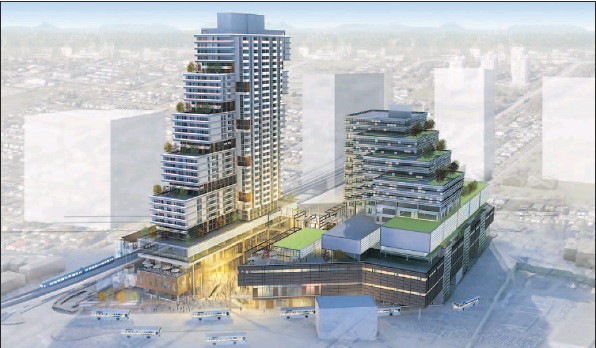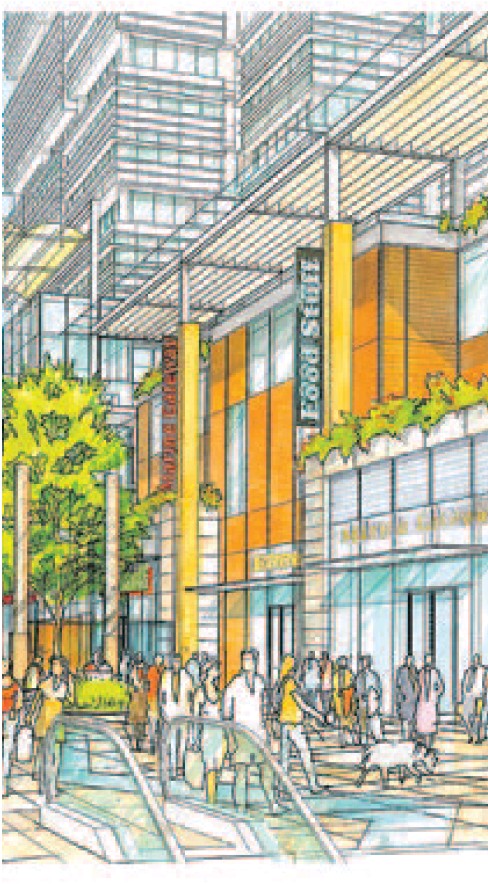Derrick Penner
Sun

Artist’s renderings ( above and below) of developer PCI Group’s proposed Marine Gateway project, a mixed-use development the company wants to build at the southeast corner of Cambie Street and Marine Drive in south Vancouver. It would include a 350-foot residential tower and a 260-foot office tower.

The Vancouver-based developer PCI Group is proposing to build the city’s tallest tower outside the downtown core as part of an ambitious redevelopment of the southeast corner of Cambie Street and Marine Drive.
Rising more than 30 storeys to 350 feet (105 metres), the proposed tower would contain 577 residential units (390 condominiums and 187 rental apartments) and form more than one-third of a sprawling 950,000-square-foot project PCI has named Marine Gateway.
The residential tower would provide housing for 750 to 850 people. A second, 260-foot office tower plus a 288,000-square-foot retail centre at its base would support 2,000 jobs, said PCI CEO Andrew Grant.
Grant said the site’s two-hectare size, plus its location practically on top of the Canada Line’s Marine Drive Station and TransLink bus exchange, begged for a substantial, “transit-oriented-design” project.
“This site, because it was a large site with a station on it, represented an opportunity for mixed-use development with job density, and our plan meets that,” Grant added.
PCI is aiming to have its rezoning complete and development-permit process concluded in time for a 2011 construction start and possible 2014 completion date.
However, the residential component is what has given the City of Vancouver pause.
The property, formerly an ICBC claims centre, is in the city’s industrial zone south of Marine Drive, and the fear is that allowing residential development would invite speculation on surrounding industrial land and drive up property values, pushing existing businesses out.
“There are certain types of job lands that need single-use in order to keep land values low and taxes low,” Brent Toderian, Vancouver’s director of planning said in an interview.
“Protecting job growth from the greater profitability of residential [development] is an absolutely key aspect of a sustainable city.”
Toderian said he believes the Marine Gateway proposal, which places all the residential development virtually on top of Marine Drive station, and sites the retail and office portions as a buffer between the industrial lands, successfully “puts a fence around” it to mitigate the negative effects.
Nonetheless, the project is still in the early stages of city approvals. City council last year gave approval in principle to removing the Marine Gateway site from the industrial zone, paving the way for a rezoning application now in the public open-house stage.
Grant said the developer will hold a second open house meeting in coming weeks.
Toderian said the city planning department’s urban design panel will also review the project and offer a recommendation of support or no support before the project goes to a full public hearing before council. That is expected to happen over the summer.
PCI has some familiarity with transit-oriented development, having built the much smaller Crossroads development at Cambie and Broadway.
“The debate usually comes down to how big is too big,” Toderian said.
He said the buildings’ height provides another challenge to make sure the development doesn’t cast a shadow over Sir Wilfrid Laurier Annex elementary school or Ash Park.
David Dove, lead architect on the project with the firm Busby Perkins + Will, said it was the introduction of transit along the Cambie corridor that made the project’s scale possible. But he said it will be less imposing once surrounding sites are developed.
“I think you have to plan for what’s going to be there in 15 years,” Dove said. Once projects now in the early planning stages for the northeast and northwest corners go ahead, he said, “there is going to be a context that makes sense.”
Toderian said that between the city and developer, “everybody agreed we want to do something bold and strategic here.”
But future development along the Cambie corridor will be “at appropriate scales and densities,” he said.
“A clear message is that what we’re talking about in this station’s context is much more ambitious and bold than what we’re prepared to support at other stations.”
© Copyright (c) The Vancouver Sun

